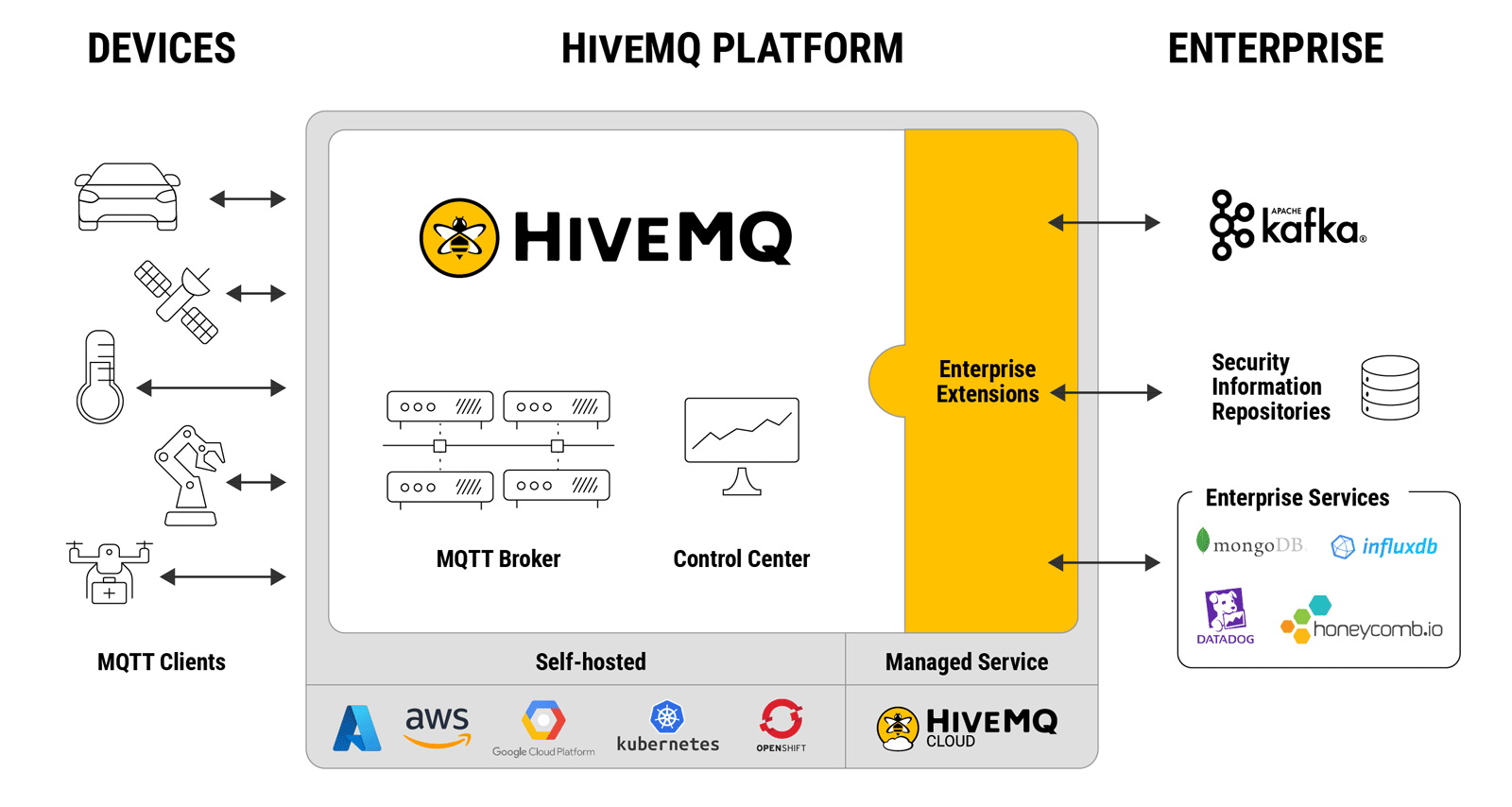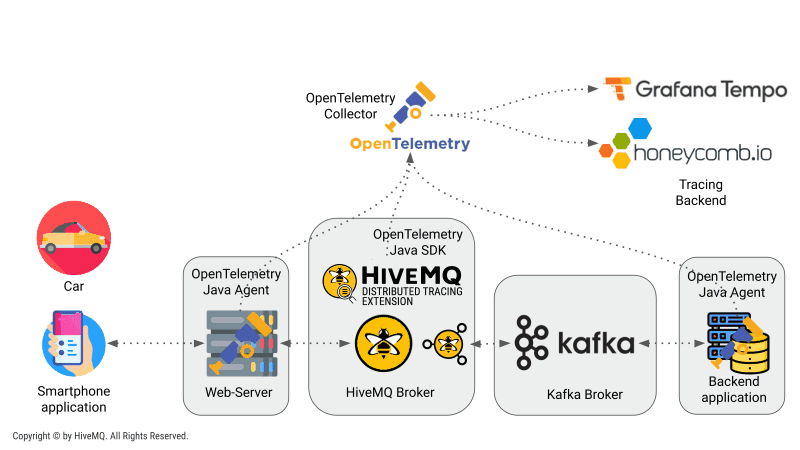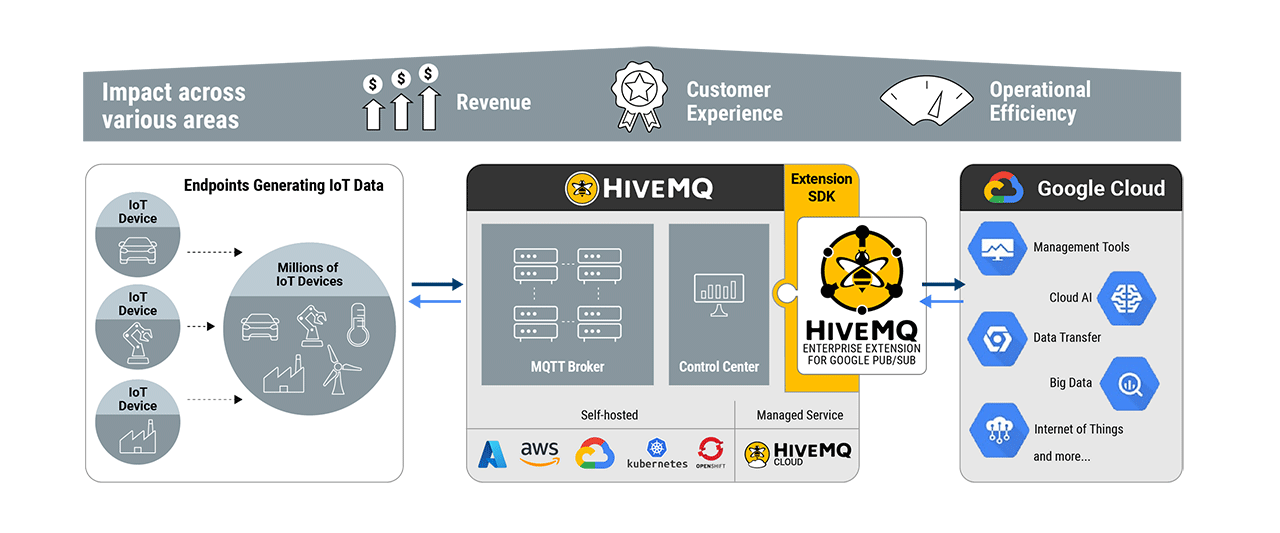Introducing HiveMQ Enterprise MQTT Platform 4.9: Enhanced IoT Observability, Google Cloud integration, and much more
We are proud to announce the release of HiveMQ Enterprise MQTT Platform 4.9. With this release, we are enhancing the observability of IoT applications for SREs, developers, and architects, providing additional flexibility to build multi-cloud and hybrid applications, and reliability controls that align with your business goals.
Highlights
The HiveMQ Enterprise MQTT Platform 4.9 makes enhancements in four areas:
- Improved observability for IoT applications thanks to distributed tracing that is underpinned by OpenTelemetry
- More flexibility in ingesting IoT data from MQTT clients into the Public cloud with general availability of Enterprise Extension for Google PubSub
- Disaster recovery tooling and controls which enhance the reliability of the architecture and help strategically address both availability and recoverability of data.
- Updated security controls which now supports basic authentication for access to REST APIs
Release 4.9 is HiveMQ’s latest LTS release and, with this release, we sunset our previous LTS version 4.5 on 31st of January, 2023.
This blog post summarizes the features included in the broker and extension updates.

Improved observability for IoT applications
HiveMQ MQTT Platform 4.9 offers the option to install the HiveMQ Enterprise Distributed Tracing Extension which helps instrument the HiveMQ broker with OpenTelemetry framework.
Why Distributed Tracing
Distributed Tracing is a method to trace messages through distributed systems in production. It allows a high-level overview of a request’s journey so teams looking for issues can isolate and then dive deeper into those individual systems.

This is helpful in situations where a production system has a problem like high latency and dropped messages, and we need to determine where the issue originates. As an example, if an ACME-built car is taking upwards of 5 seconds to unlock via their mobile app, the teams need to find out what’s causing this issue? With distributed tracing, DevOps, SREs, software architects, developers, and other technical teams can:
- Analyze message flows, end-to-end, to understand which step is causing, for instance, latency issues in an application.
- Spot critical system components and create a baseline for their performance.
- Raise tickets with the appropriate teams and vendors since they now have contextual diagnostics information.
My colleague, and software engineer, David has written a deep-dive post that describes how you can use Distributed Tracing to maximize the observability of your IoT applications.
Note: Some features (like trace propagation) require MQTT5 clients. Be sure to refer to the documentation.
More IoT data ingestion options with Google PubSub extension
HiveMQ’s cloud-native and cloud-ready nature is constantly evolving and this release furthers the flexibility of our platform and the IoT applications that customers build using the platform.
The HiveMQ Enterprise Extension for Google PubSub helps you directly ingest IoT data from MQTT client to the Google Cloud.

Why this is important
The recent deprecation of the Google IoT Core is a reminder for businesses that proprietary code and infrastructure carries a business risk that must be addressed. This extension helps you eliminate the requirement of Google IoT Core as an intermediary between MQTT clients and Google Cloud.
With bi-directional messages flowing between standards-based MQTT clients and Google Cloud, here is how your organization will benefit from (some of) the key features:
- Data Pipeline Architects will be able to leverage Google Cloud’s data lake, query, and manipulation tooling with MQTT-powered device data to create additional business value.
- Data Pipeline Architect can continue to use Google Cloud’s service accounts or WIF tokens and avoid reworking the security setting for their applications.
- Developers will be able to manipulate MQTT device data (on the fly) for analysis in tools like Google BigQuery and avoid adding more components in the workflow
For a deeper understanding of the features of this extension, please refer to this blogpost by our Senior Software Engineer, Florian Limpöck on the topic HiveMQ & Google Cloud - Enabling Bi-directional MQTT Data Movement
Note: Release 4.9 also moves the Google PubSub Extension from Early Access Preview into General availability.
Disaster Recovery Tooling and Controls
Disaster recovery strategies throw up the trade-off between data consistency and availability. Depending on the business you are in, having a low-level and granular control to assure data recoverability and system availability might be essential.
Release 4.9 brings the following capabilities to your SRE and DevOps teams
- More flexibility and options in planning for disaster recovery scenarios.
- Accommodate for both hard “zero-down-time” and “zero-data-loss” requirements
- Disaster recovery tooling to restore data from persistence and import into running cluster
- Runbooks for bare-metal and cloud-native (k8s) deployments.
While the ideal solution to assure reliability is to create hot stand-by clusters in a geographically isolated data center and similar such measures, but that would mean a multi-order increase in cost to build and operate the system.This brand new tool from HiveMQ gives you the control to factor in costs associated with recovering from a disaster and implement a sustainable strategy while delivering on hard availability and zero-data-loss requirements.
Updated security controls on the REST API
The feature-packed HiveMQ Enterprise Security Extension now includes the ability to authenticate REST API requests with a simple username and password.
This capability will help SREs and Security administrators:
- Ensure authenticated access to HiveMQ brokers via. the REST API
- Manage end-point access on individual and role-based basis
- Securely use the broker for tasks like querying broker health and automating back-up initialization etc.
Get started today
Download the HiveMQ broker and the enterprise extensions today to get started on a fully MQTT-compliant platform that is cloud-native, and built for IoT use cases that demand solid reliability, high scalability, and no-compromise on security.
Note: If you are a customer upgrading from version 4.8 to 4.9, follow the steps in the guide here: https://docs.hivemq.com/hivemq/4.9/upgrade/4-8-to-4-9.html
Check out the video below that provides the summary of this blog
HiveMQ Team
The HiveMQ team loves writing about MQTT, Sparkplug, Unified Namespace (UNS), Industrial IoT protocols, IoT Data Streaming, how to deploy our platform, and more. We focus on industries ranging from energy, to transportation and logistics, to automotive manufacturing. Our experts are here to help, contact us with any questions.
